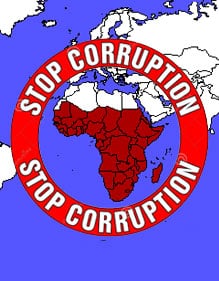|
Getting your Trinity Audio player ready...
|
 The 2015 Corruption Risk Index (CRI), a survey conducted by global risk analysis and management company Verisk Maplecroft, is out – and the news is not good for sub-Saharan Africa.
The 2015 Corruption Risk Index (CRI), a survey conducted by global risk analysis and management company Verisk Maplecroft, is out – and the news is not good for sub-Saharan Africa.
The index ranked 198 countries on their prevalence of bribery and corruption, and the effectiveness of official efforts to fight the problem. It found that sub-Saharan Africa is home to half of the 10 countries that posed the highest risk to business in terms of corruption.
This region is rich in natural resources and is experiencing rapid population growth, and hence is attracting increased investor interest. The downside to this, according to Verisk, is that companies entering the region’s markets are especially prone to demands of bribery.
The CRI also revealed that 45%, or 33, of the 73 countries rated “extreme risk” lie in sub-Saharan Africa.
Verisk’s index differs from Transparency International’s Corruption Perceptions Index in that it assesses reported levels of corruption, rather than perceptions of corruption. The CRI takes into account five key factors relating to corruption: frequency; persistence; severity; geographical and sectoral coverage; and the degree of impunity.
Africa not a shining example for the world
The Democratic Republic of Congo, with Somalia, Central African Republic, Sudan and Equatorial Guinea, all featured in the top 10. This is not a ranking to be proud of.
The 2014 index painted much the same picture – then there were six sub-Saharan African countries in the top 10, but Zimbabwe and Guinea dropped out in 2015, while Equatorial Guinea made a top 10 appearance.
South Africa then, as now, was listed as a high-risk country. Botswana, ranked at 154 and considered a medium risk, is the continent’s best performer – its performance was mentioned as a “regional anomaly” by Trevor Slack, Verisk’s principal analyst and the person responsible for researching and producing the annual CRI.
The Brics economic bloc, of which South Africa is a member, showed sluggish performance in fighting corruption, as they did in previous years, said Verisk. There are solid anti-corruption laws in all five countries, but enforcement remains consistently weak.
The CRI, according to Verisk, gives investors a “snapshot of the corruption landscape at the global, regional and national levels”. It’s complemented by more detailed briefings on particular jurisdictions, analysis of recent legislation and enforcement trends, and studies of corruption risks particular to specific sectors – such as the extractives industries, an important sector in the sub-Saharan region.
“These risks are particularly prevalent in developing economies,” said Slack. He named contributing factors such as weak rule of law and a lack of institutional capacity, which undermine efforts to combat entrenched systems of patronage. In addition, exposure to corrupt public officials and a reliance on third party agents is higher.
The report singled out one particular reason for the failure of politicians to fight bribery – senior officials responsible for addressing the issue profit from it most.
Other factors included high levels of poverty.



